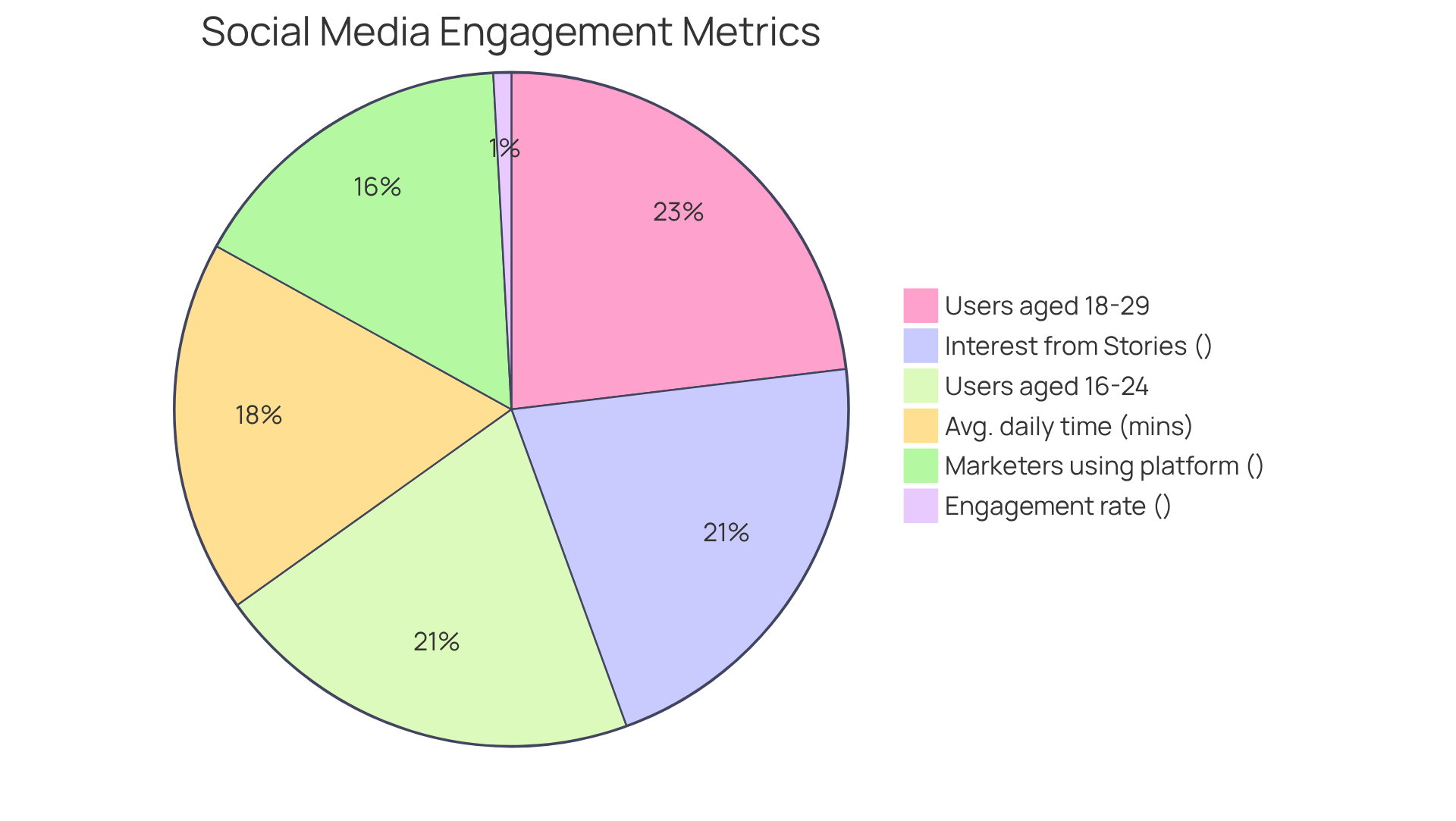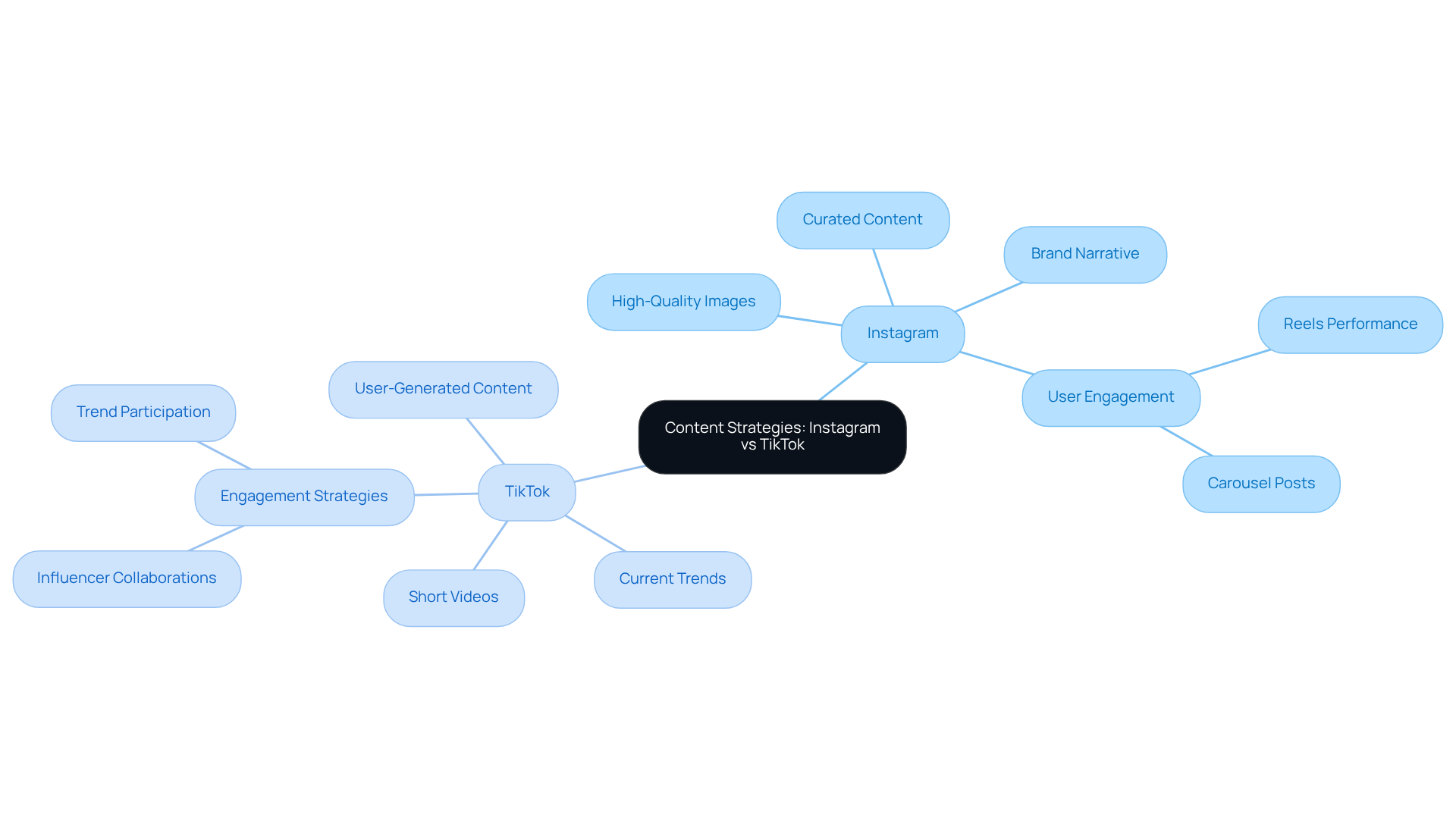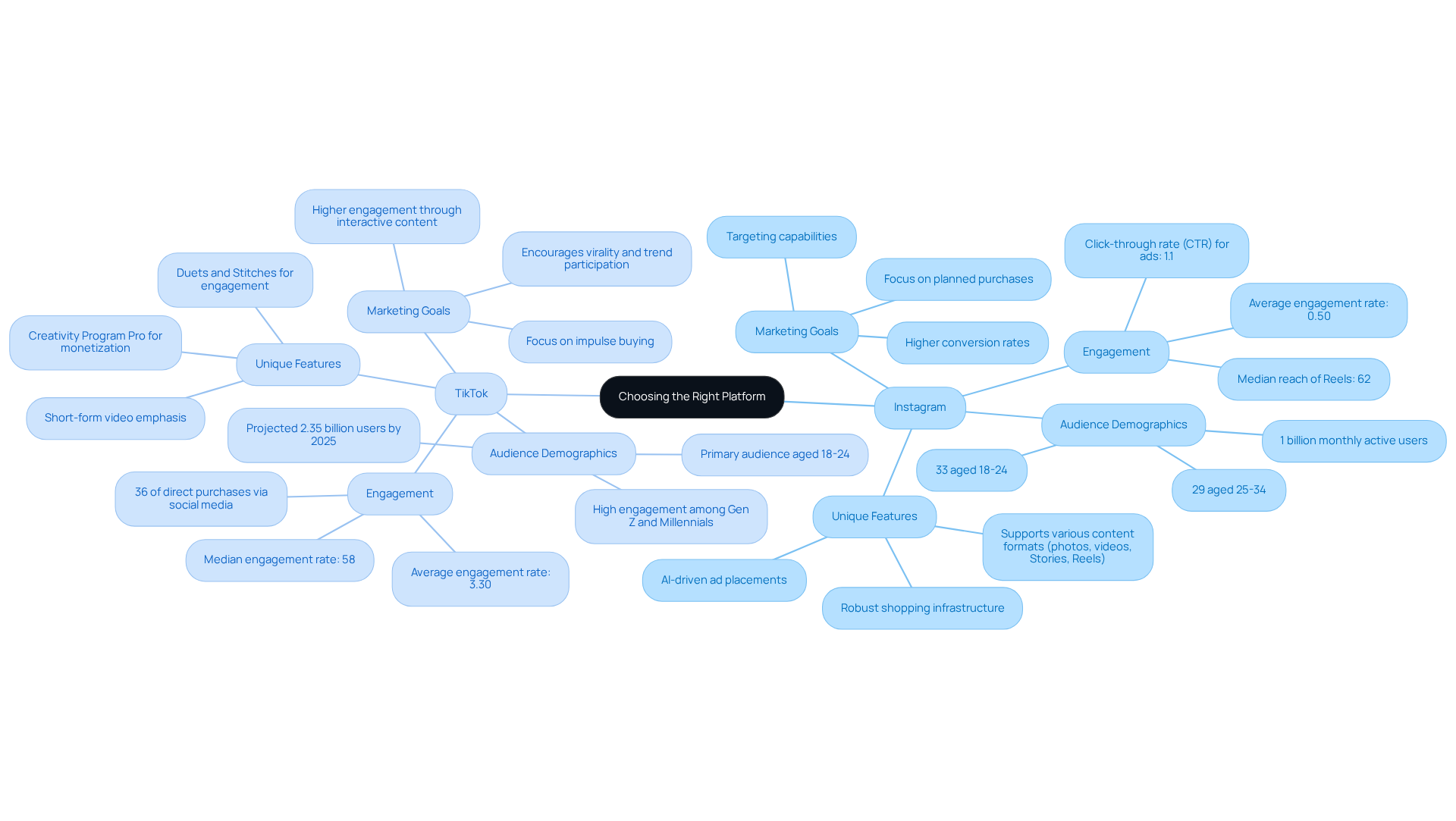Overview
Choosing the right platform for marketing can feel overwhelming for tech startup founders. With so many options available, it’s easy to feel lost. Instagram and TikTok stand out, each with its unique strengths, but how do you decide which one is right for your startup?
Instagram shines when it comes to polished visuals and appealing to slightly older demographics. It’s a platform where aesthetics matter, and many brands have found success by curating beautiful feeds. However, this can create pressure to maintain a certain image, which might not resonate with every startup's authentic voice. On the other hand, TikTok offers something different—greater engagement and virality, especially among younger audiences. This platform thrives on creativity and spontaneity, making it a fantastic option for startups looking to connect with a vibrant community.
The challenge lies in aligning your content strategy with the strengths of each platform. It’s essential to consider where your target audience spends their time and how they engage with content. This decision can significantly impact your startup's reach and success.
But don’t worry; you’re not alone in this journey. Many founders have faced similar dilemmas, and sharing experiences can be incredibly helpful. By understanding the unique characteristics of Instagram and TikTok, you can craft a strategy that feels authentic to your brand while maximizing your impact.
At RNO1, we’re here to support you in navigating these choices. We believe in nurturing your vision and helping you find the right path forward. Let’s explore how we can align your marketing efforts with the platform that best suits your startup’s goals. Together, we can create a strategy that not only reaches your audience but resonates with them on a deeper level.
Introduction
Navigating the ever-changing world of social media can feel overwhelming for tech startups trying to connect with younger audiences. With platforms like Instagram and TikTok taking center stage, it’s essential to grasp their unique user demographics and engagement metrics. Many founders find themselves asking: how can they truly harness the distinct features of each platform to build genuine connections and achieve success? This article aims to explore these challenges, offering insights that can empower startups to make informed decisions in the Instagram vs TikTok debate. Together, we’ll uncover ways to foster impactful engagement and growth, ensuring that your brand resonates with the audience you care about.
User Demographics and Engagement Metrics of Instagram and TikTok
Navigating the world of social media can feel overwhelming, especially for brands trying to connect with younger audiences. With around 67% of users aged between 18 and 29, this platform stands out as a vital space for brands targeting these demographics. Yet, the challenge remains: how do you truly engage this audience?
The rise of Gen Z on the platform is striking, with about 60% of participants aged 16 to 24, and over 135 million unique users each month in the United States. These numbers highlight a significant opportunity, but they also underscore the need for brands to adapt their strategies. Users spend an average of 52 minutes daily on this platform, far surpassing the 30 minutes seen on other social media apps. This indicates a deeper level of engagement that brands must tap into.
Moreover, the platform boasts an average engagement rate of 2.5%, showcasing its potential for fostering meaningful interactions. This is crucial for brands, especially when considering that 62% of users express increased interest in a brand after seeing it in a Story. It’s a reminder that connection matters.
As you think about your marketing resources, remember that 46.7% of marketers rely on this platform for influencer partnerships. This insight is vital for brands looking to enhance their omnichannel brand ambassador programs. By focusing on these metrics, you can make informed decisions that maximize your impact and engage your audience effectively.
At RNO1, we understand the emotional and professional challenges you face. We’re here to support you in navigating these waters, helping you forge innovative influencer partnerships that resonate with your audience. Together, we can create strategies that not only reach but truly connect with the younger generations.

Content Strategies: Instagram vs TikTok
Instagram is a powerful platform for tech startups, but navigating its landscape can feel overwhelming. Many founders struggle with how to create content that truly resonates with their audience. It’s not just about posting pretty pictures; it’s about crafting a narrative that reflects your brand’s identity and values. This can be particularly challenging when you see others thriving with polished visuals and engaging stories. The pressure to keep up can weigh heavily on your shoulders.
But here’s the good news: you’re not alone in this journey. Many startups face similar hurdles, and understanding the dynamics of Instagram vs TikTok can significantly impact their success. The platform thrives on high-quality images and curated content, but it also rewards creativity and authenticity. By embracing a more casual and relatable tone, you can connect with your audience on a deeper level. Think about it—how can you showcase your unique story in a way that feels genuine?
As we look ahead to 2025, consider focusing on visually striking images and interactive formats like carousels. These tools have proven to enhance user engagement significantly. And let’s not forget about the comparison of Instagram vs TikTok! Short, impactful videos that tap into current trends can resonate with a younger audience, helping you build authenticity and connection through user-generated content. It’s all about blending storytelling with the specific features of each platform, particularly when considering Instagram vs TikTok.
Successful tech startups have shown us that those who effectively weave their narratives into their content can maximize their reach and engagement. RNO1 is here to support you in this endeavor. Our performance marketing expertise can guide you in creating appealing content that not only captivates your audience but also drives measurable success. Together, we can navigate this competitive digital landscape, ensuring your startup not only survives but thrives. Remember, you’re part of a community that understands your challenges, and we’re here to help you every step of the way.

Engagement Techniques: Analyzing Calls to Action and Visuals
On the platform, many brands face the challenge of effectively directing traffic to their websites or product pages. It can be tough to stand out in a sea of content, especially when the focus is on high-quality visuals. In 2025, Instagram's Reels and Stories have emerged as the most engaging formats, with Reels achieving an average engagement rate of 2.08%. This highlights the importance of utilizing these features to maximize visibility and interaction.
But it’s not just about posting pretty pictures. The platform thrives on interactivity, encouraging participation through features like duets and stitches. CTAs often take the form of challenges or prompts, inviting users to create their own videos and fostering a lively community. With individual users spending an average of 25.5 hours per month on the platform and US users collectively investing 4.8 billion minutes daily in watching videos, there’s a unique opportunity for tech startups to connect with their audience in creative ways.
For tech startups, leveraging the strengths of both platforms, specifically Instagram vs TikTok, is crucial. By analyzing the strengths of Instagram vs TikTok, brands can combine the refined visuals of one platform with the interactive features of the other to significantly enhance their presence and build customer loyalty. Successful examples of interactive content, like gamified challenges or collaborative videos, resonate deeply with audiences. Adding urgency to CTAs can boost conversion rates by 332%, and with 29% of users making purchases on the platform, effective CTAs can lead to substantial sales growth.
Navigating this landscape can feel overwhelming, but remember, you’re not alone. By embracing these strategies, you can create a supportive community around your brand and foster meaningful connections with your audience.

Choosing the Right Platform: Strategic Implications for Brands
Choosing the right platform between Instagram vs TikTok can feel overwhelming for many companies. It’s essential to align your marketing goals with your target audience, and that’s where the challenge lies. For those focused on building a polished visual identity, Instagram shines brightly. It’s a space where lifestyle and luxury brands can truly thrive, reaching over 1 billion monthly active users. With 33% of users aged 18-24 and 29% aged 25-34, Instagram offers a diverse demographic that’s perfect for businesses looking to foster organized purchases and customer loyalty.
On the flip side, TikTok is designed for those wanting to connect with younger audiences through vibrant, engaging content. Its primary audience is aged 18-24, and the platform’s algorithm is all about encouraging virality and engagement. If your company emphasizes creativity and staying on top of trends, TikTok could be your best friend. With projections suggesting it will reach around 2.35 billion users by 2025, its rapid growth and cultural relevance are hard to ignore. Plus, TikTok’s Creativity Program Pro offers monetization opportunities that can make it even more appealing for brands.
As a tech startup, it’s crucial to assess your product offerings, communication style, and audience preferences when deciding on Instagram vs TikTok. For instance, if you’re targeting impulse shoppers, TikTok’s short-form video style and engaging functionalities might resonate more. Did you know that 36% of direct purchases through social media happened on TikTok, especially among Gen Z and Millennials? In contrast, Instagram’s robust shopping infrastructure and precise targeting capabilities make it a strong contender for businesses focused on conversion and customer retention. However, it’s worth noting that Instagram’s average engagement rate is expected to drop to 2.50% in 2025, down from 2.65% in 2023. This is something to consider as you strategize your approach.
Ultimately, leveraging the unique strengths of each platform in the debate of Instagram vs TikTok can significantly enhance your visibility and engagement, paving the way for long-term success in a competitive digital landscape. By aligning your marketing initiatives with the features of both Instagram vs TikTok, you can navigate the complexities of today’s consumer behavior more effectively. Remember, 39% of all consumer purchases were influenced by Instagram, highlighting its impact. And don’t forget about TikTok’s unique features like Duets and Stitches, which can offer additional creative engagement opportunities for your brand.
In this journey, know that you’re not alone. Many founders face similar dilemmas, and by sharing experiences and insights, we can all grow together.

Conclusion
Navigating the social media landscape can feel overwhelming for tech startups, especially when trying to connect with younger audiences. It’s a common struggle, and many founders find themselves wondering how to effectively engage in this fast-paced digital world. The distinct advantages of platforms like Instagram and TikTok can seem daunting, but understanding how to leverage these tools can truly make a difference in enhancing your brand's visibility and engagement.
Instagram shines with its polished visuals and curated narratives, making it a perfect fit for brands that prioritize aesthetics and lifestyle. On the other hand, TikTok thrives on creativity and trend-driven content, offering a unique opportunity for brands to engage younger consumers through interactive and viral experiences. By embracing the strengths of each platform, you can maximize your reach and foster deeper connections with your audience.
Ultimately, the choice between Instagram and TikTok should align with your brand's goals and target demographics. As social media continues to evolve, it’s essential to remain agile and adapt your strategies to harness the power of these platforms effectively. Embracing this knowledge not only enhances your brand visibility but also helps build a community that understands and supports the unique challenges of today’s digital landscape. Remember, you’re not alone in this journey; many founders share similar experiences, and together, we can navigate these challenges with confidence and creativity.
Frequently Asked Questions
What is the primary age demographic of Instagram users?
Approximately 67% of Instagram users are aged between 18 and 29.
How significant is the presence of Gen Z on Instagram?
About 60% of Instagram participants are aged 16 to 24, with over 135 million unique users each month in the United States.
How much time do users spend on Instagram daily compared to other social media apps?
Users spend an average of 52 minutes daily on Instagram, which is significantly more than the 30 minutes spent on other social media apps.
What is the average engagement rate on Instagram?
The average engagement rate on Instagram is 2.5%.
How do Instagram Stories impact brand interest among users?
62% of users express increased interest in a brand after seeing it in an Instagram Story.
What percentage of marketers use Instagram for influencer partnerships?
Approximately 46.7% of marketers rely on Instagram for influencer partnerships.
Why is understanding these metrics important for brands?
Understanding these metrics helps brands make informed decisions to maximize their impact and effectively engage their audience.




